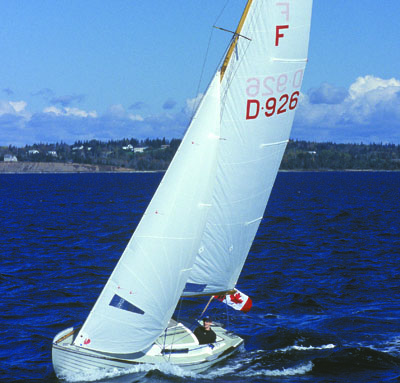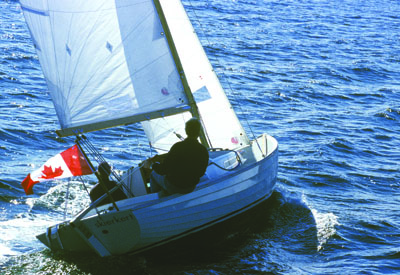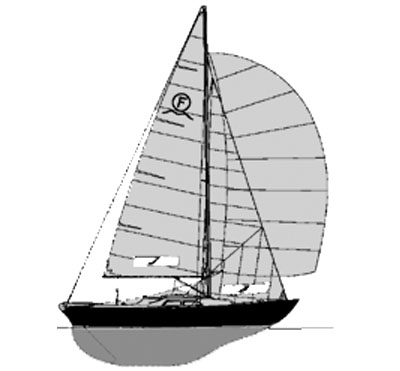A Folkboat on Mahone Bay
 By CY Staff
By CY Staff
It is that boat that most of us know from pictures, we’ve read about it but we haven’t sailed it, at least we hadn’t. During the sixties there was a real fleet of them on Lake Ontario, but other than in the San Francisco Bay area the boat got somewhat forgotten in North America.
Toon Nagtegaal, who moved from the Netherlands to Nova Scotia a year and a half ago wants to change that. In his words, simply because we deserve it. “It’s a great little boat and it is superbly well suited for these waters and if it was good for Lake Ontario then, it is good for it now.”
A beautiful September morning and the wonderful setting of the Lunenburg Yacht Club make a good appetite for a nice day of sailing. Toon’s boat is a light grey fiber version of the Folkboat, built in 1996 by Folkebådcentralen of Denmark. Folkebådcentralen, established in 1977 by Erik Andreasen is in a way very much responsible for the success of the class today. They convinced the class association to approve the fiber version and since then over a thousand of them were built. The fiber Folkboat has the same weight and weight distribution as the wooden one and both versions race among each other.
With more than 4000 Folkboats afloat, it’s is one of the largest international one design keelboat classes in the world. Forty new boats are added to the fleet every year, which makes this class a sixty two year old but very vivid beauty.
Toon’s boat “Skierkert” (Frisian for grey one) is moored at the western most part of the mooring field. “May be not the best protected spot, but best for leaving and returning under sail. I hardly ever use the outboard”. We immediately notice the wooden mast. Although aluminum spars are approved a few years ago wood is still far more popular.
We sail off in not more than a light breeze as we are in the lee of Second Peninsula. It gives us time to have a good look above and under deck. The rig is very simple. The jib measures 7 sq. meter and the main 17. The mast is keel stepped and two shrouds and a forestay take care of the lower section of it. Diamond stays, the tension of which can be adjusted by a bottle screw at boom height, supports the upper mast section. Apart from the main halyard all lines are neatly led into the cockpit.
 The cockpit isn’t overly spacious but there is room enough for a racing crew of three and day sailing with four is fine as well. The helmsman has his own space behind the traveler strut (height adjustability is an option) and a wonderfully crafted seat that slides from under the aft deck. The large rudder hangs outboard of the transom and the tiller sweeps across the aft deck out of the crew’s way. The outboard engine is mounted on the transom and is hoisted clear of the water onto the aft deck via a pair of sliding rails.
The cockpit isn’t overly spacious but there is room enough for a racing crew of three and day sailing with four is fine as well. The helmsman has his own space behind the traveler strut (height adjustability is an option) and a wonderfully crafted seat that slides from under the aft deck. The large rudder hangs outboard of the transom and the tiller sweeps across the aft deck out of the crew’s way. The outboard engine is mounted on the transom and is hoisted clear of the water onto the aft deck via a pair of sliding rails.
The cabin is according to today’s standards small. Don’t even think of standing head room, sitting is fine though. The berths are long and comfortable and the vee forward would accommodate a couple in love or two children. Toon’s boat has the “Lux” outfit with galley table, drawers mirror, cupboards, a wine storage arrangement and a magazine shelf and the ambiance is all about teak and an Oregon pine ceiling. The materials used and finish are excellent, you could say beyond today’s standards. Oh, and there’s no head. There’s a bucket and if you want to, you can have it housed in a nicely crafted teak surround.
When we pass a lower section of Second Peninsula Skierkert immediately picks up speed. She does it in a way though you’d expect from bigger boats, in a gentle way. As we’re approaching the open sea the wind is increasing to some 10 to 12 knots and sailing windward we’re doing an easy 5 to 5.5 knots. Although she shows initial tenderness the boat is very steady and the pressure on the tiller doesn’t increase, she just sets into the groove and keeps on moving. A very safe and comfortable feeling which is increased by the deep cockpit. The waves of the open ocean, where we’ve arrived in the meanwhile don’t bother her or us. We’re spending most of our time outside the cockpit sitting on the “old man’s seat” a part of the toe rail that widened and holding the tiller extension I’m experiencing a new feel of sailing. While moving gently as a bigger boat there is this finger tip and bud feeling of dinghy sailing at the same time.
Some facts for explanation and history as illustration; Although only 25ft long this boat weighs 1,960 kg and has a ballast ratio of 53%. Two Folkboats, Jester and Eira, took part in the first OSTAR race in 1960. Several single handed circum navigations have been undertaken with Folkboats and let’s not forget the Folkboat stood model for numerous well known pocket cruisers like the Contessa 26 and the Marieholm IF.
 Toon wants us to tack and gibe under these circumstances so we do and we agree; this is very good natured little boat. The hull feels very stiff and appears to be sound. Toon informs us that the fiber Folkboat in order to have the same weight and weight distribution as the wooden one has a hull of solid glassfiber that is up to 15.5 mm thick. The hulls show great integrity and proof of that may be that this years Gold Cup, the unofficial World Championsip, was won with a boat that was built by Folkebådcentralen 22 years ago.
Toon wants us to tack and gibe under these circumstances so we do and we agree; this is very good natured little boat. The hull feels very stiff and appears to be sound. Toon informs us that the fiber Folkboat in order to have the same weight and weight distribution as the wooden one has a hull of solid glassfiber that is up to 15.5 mm thick. The hulls show great integrity and proof of that may be that this years Gold Cup, the unofficial World Championsip, was won with a boat that was built by Folkebådcentralen 22 years ago.
Back into the Mahone Bay, we sail down wind towards Big Tancook Island and a broad reach for the town of Mahone Bay. We’re doing six knots now and pretty often we’re close to seven. The proprietor of Folkboat Atlantic has a big wide grin on his face and we’re not bad either.
Mahone Bay has an Island for every day of the year, so they say and since we have some time left we decide to enjoy the scenery a bit. Toon shows us a wonderful passage between the main land and several small islands from Mahone Harbour to Indian Point. Some parts of this passage are so narrow that we have difficulties to keep the sails filled. Skierkert keeps track easily though, also under these circumstances. Her, at first sight, disproportional weight in combination with a long and relatively deep (1.20 meter) keel again shows advantages.
We’re rounding Zwicker Island and to our surprise the wind picks up seriously and we need to tack our way through smaller islands, shallows and rocks in a fresh breeze. “Typical for the South Shore” says Toon, “always a nice breeze in the afternoon”.
Under these circumstances you’ll appreciate a deck and cockpit lay-out that is intuitively right. The permanently winch handles are mounted below the side decks and are tensioned by a shock cord. The end of the jib sheets are attached to the winch handles (port sheet to starboard handle, starboard sheet to port handle). It allows the crew member in charge to stay at the weather rail; a very simple but wonderful feature and of course of great value for single handling.
With the lee rail staying down and the tiller remaining in the centre of the boat we leave the islands and the rocks behind us, rounding Backmans Island and head for the Yacht Club where we indeed moor without using the engine.
While having a beer on the terrace and watching “Skierkert” I can only conclude that this is a beautiful boat. She is definitely very good looking and she sails as good as she looks. The Folkboat is very well built and beautifully finished.
Originally published in Canadian Yachting’s December 2004 issue.
Specifications:
Length: 7.64m
LWL: 6.00m
Beam: 2.20m
Draft: 1.20m
Displacement: 1960 kg
Sail Area: 24 sq/m
Mast Height: 10.80m
Base Price (imported): $60,000
Contact:
Folkboat Atlantic
P.O. Box 84, Riverport, NS B0J 2W0
Tel: 902-766-0340
toon@folkboatatlantic.com






















